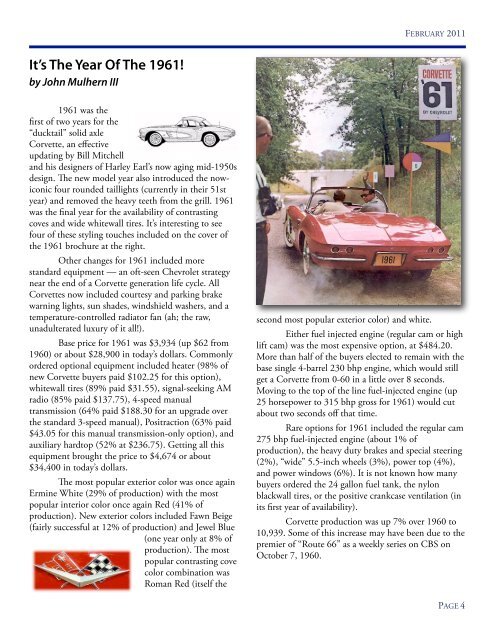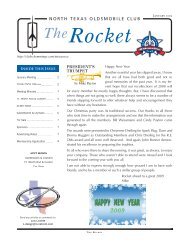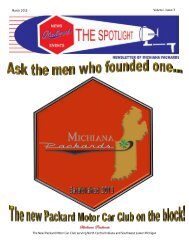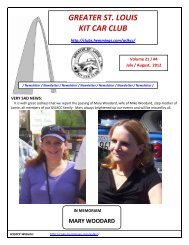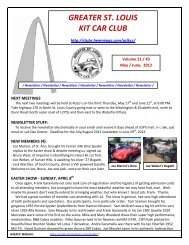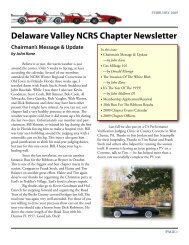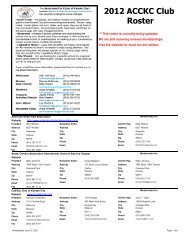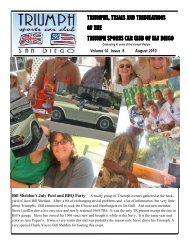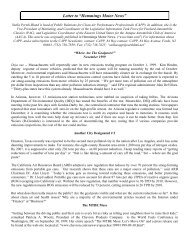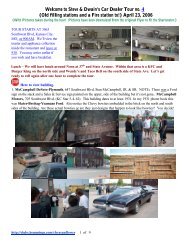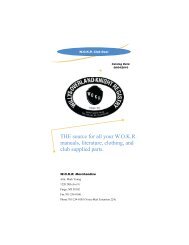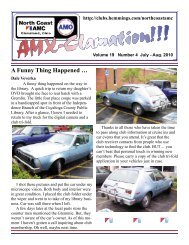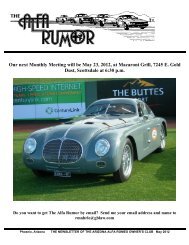Delaware Valley NCRS Chapter Newsletter - Clubs
Delaware Valley NCRS Chapter Newsletter - Clubs
Delaware Valley NCRS Chapter Newsletter - Clubs
You also want an ePaper? Increase the reach of your titles
YUMPU automatically turns print PDFs into web optimized ePapers that Google loves.
It’s The Year Of The 1961!<br />
by John Mulhern III<br />
! 1961 was the<br />
rst of two years for the<br />
“ducktail” solid axle<br />
Corvette, an effective<br />
updating by Bill Mitchell<br />
and his designers of Harley Earl’s now aging mid-1950s<br />
design. e new model year also introduced the nowiconic<br />
four rounded taillights (currently in their 51st<br />
year) and removed the heavy teeth from the grill. 1961<br />
was the nal year for the availability of contrasting<br />
coves and wide whitewall tires. It’s interesting to see<br />
four of these styling touches included on the cover of<br />
the 1961 brochure at the right.<br />
Other changes for 1961 included more<br />
standard equipment — an oft-seen Chevrolet strategy<br />
near the end of a Corvette generation life cycle. All<br />
Corvettes now included courtesy and parking brake<br />
warning lights, sun shades, windshield washers, and a<br />
temperature-controlled radiator fan (ah; the raw,<br />
unadulterated luxury of it all!).<br />
Base price for 1961 was $3,934 (up $62 from<br />
1960) or about $28,900 in today’s dollars. Commonly<br />
ordered optional equipment included heater (98% of<br />
new Corvette buyers paid $102.25 for this option),<br />
whitewall tires (89% paid $31.55), signal-seeking AM<br />
radio (85% paid $137.75), 4-speed manual<br />
transmission (64% paid $188.30 for an upgrade over<br />
the standard 3-speed manual), Positraction (63% paid<br />
$43.05 for this manual transmission-only option), and<br />
auxiliary hardtop (52% at $236.75). Getting all this<br />
equipment brought the price to $4,674 or about<br />
$34,400 in today’s dollars.<br />
e most popular exterior color was once again<br />
Ermine White (29% of production) with the most<br />
popular interior color once again Red (41% of<br />
production). New exterior colors included Fawn Beige<br />
(fairly successful at 12% of production) and Jewel Blue<br />
(one year only at 8% of<br />
production). e most<br />
popular contrasting cove<br />
color combination was<br />
Roman Red (itself the<br />
second most popular exterior color) and white.<br />
FEBRUARY 2011<br />
Either fuel injected engine (regular cam or high<br />
lift cam) was the most expensive option, at $484.20.<br />
More than half of the buyers elected to remain with the<br />
base single 4-barrel 230 bhp engine, which would still<br />
get a Corvette from 0-60 in a little over 8 seconds.<br />
Moving to the top of the line fuel-injected engine (up<br />
25 horsepower to 315 bhp gross for 1961) would cut<br />
about two seconds off that time.<br />
Rare options for 1961 included the regular cam<br />
275 bhp fuel-injected engine (about 1% of<br />
production), the heavy duty brakes and special steering<br />
(2%), “wide” 5.5-inch wheels (3%), power top (4%),<br />
and power windows (6%). It is not known how many<br />
buyers ordered the 24 gallon fuel tank, the nylon<br />
blackwall tires, or the positive crankcase ventilation (in<br />
its rst year of availability).<br />
Corvette production was up 7% over 1960 to<br />
10,939. Some of this increase may have been due to the<br />
premier of “Route 66” as a weekly series on CBS on<br />
October 7, 1960.<br />
PAGE 4


